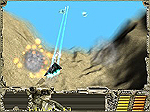By Rolando Garcia
Natural Sciences and Mathematics Communications
If students needed another excuse to fritter away hours at a game console playing Halo or Madden NFL, now they have one…career training.
A generation raised on PlayStation, Xbox and Nintendo can now learn how to build its own video games and gain skills that could prove marketable in the burgeoning game industry.
 This fall UH’s computer science department debuted a new course on interactive game development that teaches students the fundamentals of game programming and graphics. The course’s two dozen slots filled immediately after registration opened, and students’ fervor hasn’t waned. This fall UH’s computer science department debuted a new course on interactive game development that teaches students the fundamentals of game programming and graphics. The course’s two dozen slots filled immediately after registration opened, and students’ fervor hasn’t waned.
“I’ve never seen such enthusiasm and excitement in a class,” said Chang Yun, a computer science Ph.D. student who helps computer science professors Olin Johnson and Zhigang Deng teach the course. “Students are really having fun with it.”
Students develop games using Microsoft’s XNA game design and management system. The recent release of XNA paved the way for independent developers and hobbyists to try their hands at game development, and now some 30 universities offer game development courses, Johnson said.
Before XNA, programming required writing thousands of lines of code. Now a game can be built in a month, Johnson said. Although Microsoft sells the popular Xbox game system, learning the basics of game development on XNA also will prepare students to work with other game systems.
With video game sales surpassing Hollywood box office receipts, job opportunities are growing in game programming and graphics.
“This is a more interactive generation, and we want them to give them a little experience in this activity,” Johnson said.
The course work includes an individual project and a group project at the end of the semester in which students will showcase the games they have developed. Games will be graded on creativity, fun and attention to detail. The graphics, movements and music should all be synchronized, Johnson said.
Projects include singe and multiplayer game and three dimensional graphics. Students are already fleshing out concepts for their end-of-semester projects. One game features a cowboy riding through a 3-D town killing bad guys. In another, called “Santa’s Helper” the player must quickly and accurately dole out presents to the good children and lumps of coal to the naughty children.
Other games revolve around racing, kung-fu, ninjas and even Mexican wrestling.
“We want them to have fun with their games,” Johnson said.
The class will be followed by an advanced gaming course next semester, and most students already have indicated they plan to enroll and continue their video game studies. Plans are under way to make the classes – which are open to both graduate and undergraduate students – a permanent fixture on the department’s course offering, Johnson said.
Deng and Johnson instruct the class and are assisted by Yun, who teaches programming, and Jose Baez-Franceschi, a UH systems analyst who teaches animation and graphics. |

